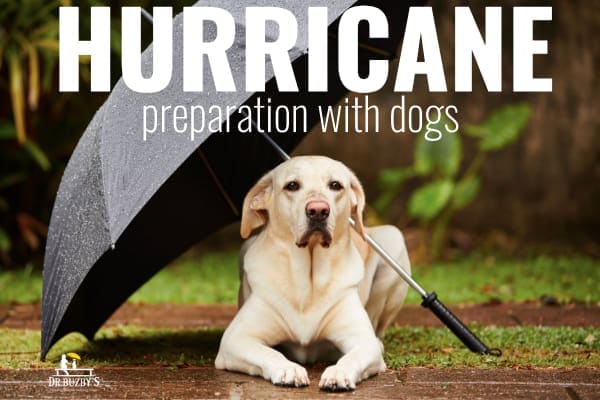
SUMMARY: Especially during a hurricane evacuation or other emergency, your furry family members need your love, care, and attention. Having traveled with her dogs while evacuating for Hurricanes Florence, Irma, and Matthew, integrative veterinarian Dr. Julie Buzby shares 10 tips for preparing your family—furry and otherwise—for a disaster.
According to the National Weather Service, hurricane season occurs from June 1 to the end of November and sharply peaks from late August through September. Stealthily, while parents were busy getting their kids back to school, peak season descended upon us.
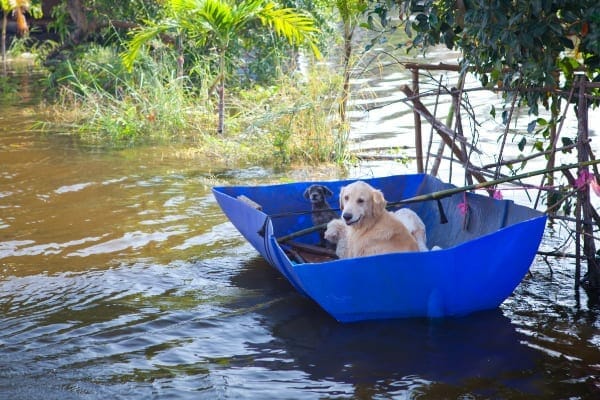
As Hurricane Dorian creeps closer, another evacuation looms imminent for my family and hundreds of thousands of others. People are frantically buying bottled water and plywood. There’s the smell of panic in the air, and it reminds me how critical it is to do our disaster preparedness homework ahead of time because it’s hard to think straight in the moment.
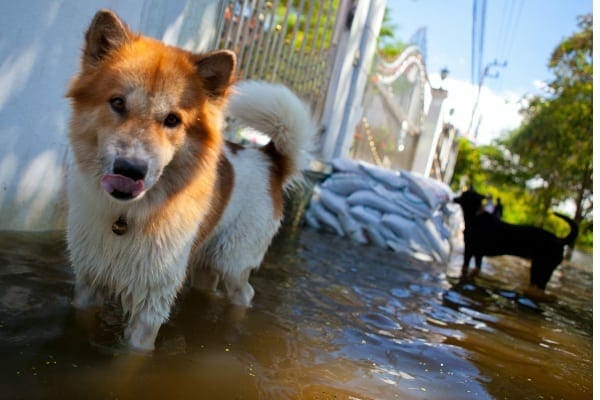
As a veterinarian and a three-time hurricane evacuee, I have real-life experience evacuating with pets (and eight children). I’ve learned a lot through the process and I’ve made some mistakes too. By sharing my list of 10 tips for evacuating with pets, I hope it will make your life smoother now (should you be in Dorian’s path) and in the future, should you ever need to evacuate due to a hurricane or other natural disaster.
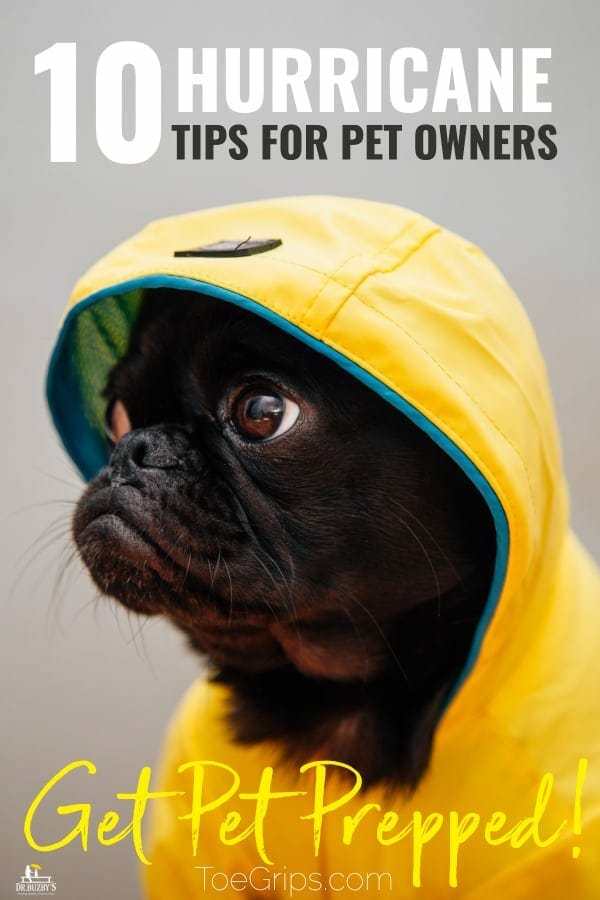
10 things I learned from evacuating with pets
1. Put a disaster plan A (and B) in place for your dog’s safety
Dwight Eisenhower said, “In preparing for battle, I’ve always found that plans are useless, but planning is indispensable.”
I don’t know that I’d call my plans useless, but certainly, by the time we’re actually on the road in our 15-passenger van, I’m usually on Plan F of my “A
The first two times our family evacuated, we followed our standard evacuation route and plan. However, the third time, the hurricane’s path crossed that evacuation route. I failed to have a plan to evacuate in a different direction (south) and it cost me roughly seven hours in researching, emailing, and handling responses. In the end, we landed what appeared to be the last pet-friendly VRBO in Florida. It was an ordeal.
I can’t stress enough the importance of planning. I
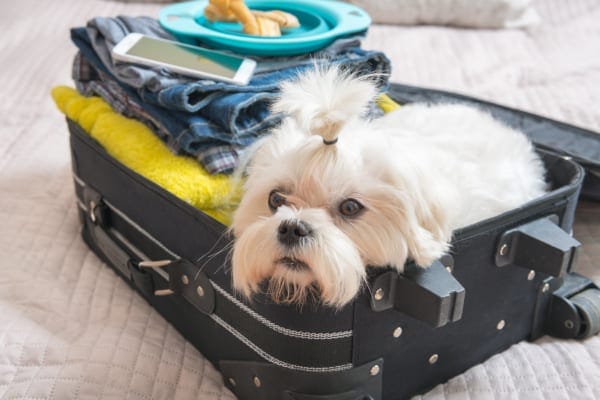
best gifts you can give your furry family members.
As you plan for a hurricane evacuation or other emergency, here are my suggestions:
- Create a list of pet-friendly hotels/motels where you plan to seek refuge. (Consider including VRBOs or AirBnBs in the area too.) Check if the accommodations have any restrictions on number, size, or species of pets. We evacuated with three large dogs. Some places were not willing to work with me on that. However, even if there are restrictions, ask if they’ll extend grace during an emergency. Many will.
- Keep your list of pet-friendly hotels/accommodations handy with other emergency phone numbers on your phone.
- Investigate veterinary hospitals in the area where you plan to stay. If your dog needs medical attention while you’re displaced, you’ll save time and stress by having the name, address, and phone number handy.
- If your dogs cannot stay with you for some reason, have a list of boarding facilities or veterinary hospitals that offer boarding in the area. It’s important to call ahead for a reservation as soon as you plan to evacuate because of the high demand.
2. Keep your dog’s medical records with you
It’s so important to bring a copy of your dog’s medical records along when you travel for any reason. You will likely need proof of vaccine history if you board your dog. Keep the records in a safe place. My husband scans them and puts them in his phone. I have a yellow folder in our van’s console at the ready.
Your veterinarian will be happy to provide a copy of your dog’s health records (generally free of charge) just for the asking.
3. Make certain that your dog is up-to-date on vaccinations
I know it’s impossible to predict an emergency, but it is wise to think about contingencies and have a plan. This includes thinking through your dog’s vaccinations and discussing them with your vet.
Here’s my personal story of how my dogs’ vaccinations impacted our hurricane evacuation plan:
Due to my dogs’ fairly sequestered lifestyle (no doggie daycare, no dog parks, very few neighborhood dogs, etc.), they don’t receive some vaccines that are deemed “non-core.” Now please understand, I’m not saying that those are bad vaccines or that you shouldn’t get them. What I am saying is that you should talk to your veterinarian about your dog’s risk. This is really an individual decision based on the dog’s environment and lifestyle.
However, this strategic decision impacted our evacuation plan. The day before we chose to evacuate, my plan was to board the dogs with a colleague at a veterinary clinic near our “safety” destination. However, this became a problem because my dogs had never been given the “dog flu” vaccination, which was required by the vet hospital where they were going to be boarded.
Even if I had them vaccinated immediately, the vaccine doesn’t protect them immediately. Also, in the case of influenza, my dogs would have needed a series of immunizations before they were fully protected. Since they wouldn’t be fully protected for the few days they would be staying at the vet hospital, I needed to switch to plan B and find dog-friendly accommodations.
4. Have a pet first aid kit packed and ready
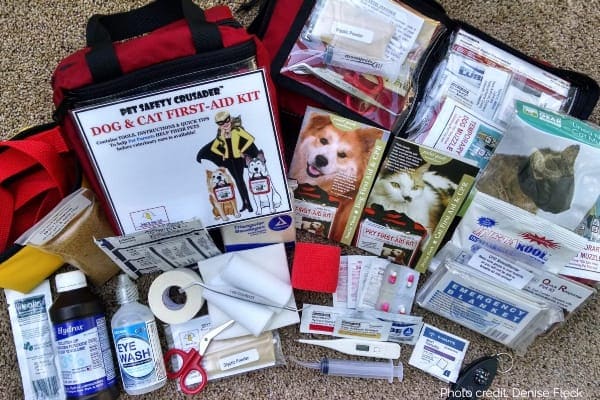
This is one example of an emergency kit created by Pet Safety Crusader.
Photo credit: Denise Fleck
Before evacuating with your pets, remember to pack your canine first aid kit. If your dog gets lacerated at a rest area, you will need material to stop the bleeding. If your dog’s face swells up from a bee sting, you’ll need to be prepared. At your next vet visit, ask your veterinarian what she or he recommends including in an emergency kit for your dog.
I have two pet first aid kits. I keep one in the car and one at home. My travel first aid kit includes all the “at-home” emergency items plus essentials for on-the-road pet emergencies. If you’re preparing your pet first aid kit as part of your hurricane evacuation plan, here is an easy checklist to follow:
On-the-go travel kit safety items for the vehicle:
- Flares
- Flashlight
- Safety vest
- Blanket
- Muzzles (Yes, you should keep a muzzle for your dog. Painful dogs often bite, and keeping the caregiver safe is a priority.)
- Leash
Dog first aid kit items for your home or for your home-away-from-home:
- A copy of your dog’s medical records
- Extra leash and collar
- Treats
- Benadryl (Include the appropriate dosing size for your dog. For example, you may choose capsules for big dogs and children’s liquid for small dogs. Check with your vet for proper dosing. Also, check the label and make sure medications do not include xylitol, which is harmful to dogs.)
- Exam (disposable) gloves
- Scissors
- Bandage material–4×4 gauze pads, 2 compressed gauze bandage rolls
- Telfa pads (specialized gauze pads used for wound care)
- 4″ elastic bandage (think Ace wrap)
- Elasticon (cotton elastic tape with a rubber-based adhesive)
- Vet wrap
- Medical adhesive tape
- Saline eye rinse
- Tweezers
- Tick remover
- Instant cold pack (the squeeze-and-go type that doesn’t require refrigeration)
- Thermometer and KY jelly for insertion
- Hydrogen peroxide
- Muzzle (I keep one in both kits. Even at home or at your home-away-from-home, a painful dog can bite.)
- Phone number for animal poison control (For the ASPCA Animal Poison Control phone number, click here.)
5. Create a list of all the physical necessities
Having a checklist of all your dog’s supplies will keep you organized when it’s time to evacuate. An emergency preparedness list of your dog’s daily care necessities may include:
- Dog food
- Water
- Food and water bowls
- Treats
- Medications
- Collar and leash with proper identification
- Poop bags
- Blanket
- Crate or travel kennel
- Disaster kit, emergency kit, or first aid kit
- Emergency contact information including phone numbers
6. Protect your dog by teaching crate training
I strongly recommend having a crate or pet carrier for each of your dogs and crate training them. It’s a “life skill” dogs need to know.
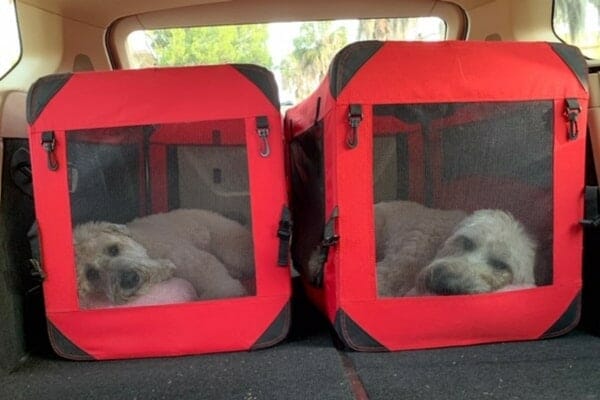
Teaching your dog to feel at home in a crate can be a tedious process. I’ve crate trained several dogs. It can take some time, some energy, and some patience. However, the fact that my dogs are crate trained is a huge asset for travel, for emergencies, and even if they would ever have to be hospitalized at the vet clinic in a cage.
It’s critical that when you evacuate for a hurricane (or any time you travel with your dog), that you have a way to safely secure your pets—whether it be a crate/carrier or a doggie seatbelt. Even with the frantic, hurried stress that an evacuation brings, please don’t
So I’m a huge fan of crates and pet carriers. Keep one in your vehicle or include it on your packing checklist.
7. Plan for your dog’s “emotional” necessities
Your dog’s emotional well-being is as important as his or her physical well-being. Change is hard on all of us. Your dog will perceive your stress and be affected by disruption of his routine.
As you make hurricane preparedness plans, anticipate your dog’s emotional state. Is your dog more anxious during travel? How is your dog going to travel best? Are there any parts of your dog’s schedule that you can maintain?

remember to bring your dog’s favorite toy for added comfort and security.
Keep your dog as calm and relaxed as possible by remembering to include his or her go-to snuggle items. This may be a favorite blanket or a toy.
By bringing along the comforts of home and by keeping the family pack together (humans and pets), you’re helping your dog stay emotionally healthy through a difficult situation.
8. Safeguard your dog with proper identification

a collar and ID tags with proper identification.
Heaven forbid, in the process of evacuating—stopping at rest areas, stopping at gas stations, car doors
Also, make sure that you have a current photo of your dog. For most dog owners, they have plenty of pictures handy on their phones. Heaven forbid, if your dog happens to get separated from you, you’ll have a current photo to share on social media or on posters.
9. Discuss what to do if you’re out of town
Here’s another important scenario to include in your emergency preparedness plan that most people don’t consider. What would you do if you were out of town and your dog was staying at the vet or a boarding facility and a mandatory evacuation was issued? As a veterinarian, I’ve seen this unfold first hand.
It’s important to have a pre-arranged plan with someone who will be responsible for picking up your dog in the event of any sort of disaster. Be sure to leave this plan with the emergency volunteer’s contact information in your dog’s records in your absence.
10. Speak with your veterinarian
If you know that your dog doesn’t travel well, speak with your veterinarian in advance about prescription options to include in your first aid kit. And if you need a refill on an emergency basis, please be understanding that it may take longer to fill than normal. Your veterinarian and the staff will be helping a lot of people refill medications for their pets before a storm hits while facing evacuations for their own families and the families of their staff.
If you’re planning to evacuate for Hurricane Dorian (or even considering it) and your dog needs prescription medications for anxiety/travel, please don’t wait. Contact your veterinarian NOW.
Get pet prepped!
A hurricane evacuation is a perfect storm (no pun intended) for unforeseen disasters for pets and people. Please take some time out of your busy life to think through your disaster plan. I encourage you to write some things down, talk with family members, get in touch with your vet, and really lay out the details for your pet’s well-being, as well as your own!
I hope that by sharing my top 10 tips, I’ve helped you and your beloved dog stay protected from danger. Ultimately, my passion is helping you help your dog. And helping you care for your pet in the event of a hurricane evacuation or other natural disaster is an important part of that mission.
How do you prepare your pet for a hurricane or natural disaster?
Please comment below. We can all learn from each other.


You made a good point that my dog’s needs should be included when preparing a disaster kit for hurricanes. I’m planning to go to a veterinarian hospital soon because there seems to be some irritation going on with my dog’s right ear that needs to be checked. If this would require some medication, I will have to buy extra to store in my disaster kit.
Great job being prepared, Alice, and I hope your dog’s ear issue resolves quickly. 🙂
What a great article. We’re not in hurricane country, but we are in wildfire country and plan to borrow heavily from the ideas in this article. Thank you!
Thanks so much, Tom, for your kind words! I really do think the Boy Scouts have it right with their “be prepared” motto. 🙂
Thanks great tips and list!!
I’m so glad that you found it helpful, Sandra! Thank you for the comment!
Excellent tips as always Dr. Julie, and two things I’ve learned from others along the way that I always like to pass along are: 1) Stash doggie shampoo, because especially if it is a hurricane or if there are flood waters, you don’t want the bacteria staying on your pet to be potentially licked off and ingested; and 2) Ahead of time, especially if you will be hunkering down at home, teach dogs to “potty” in alternate places. Our dogs are creatures of habits, and once they’ve learned to answer nature’s call outdoors, they won’t go on paper in the corner of a garage or covered patio, but when conditions are bad, we may need them to or they will “back their systems up.” Kind of a weird thing to think about, but if they won’t go to the bathroom for days, you have a whole ‘nother problem to deal with. Stay safe everyone! –The Pet Safety Crusader
These are great tips, Denise! Thank you for sharing them with our readers! Thank you for all you do as the Pet Safety Crusader to educate us all on keeping our pets safe and healthy!